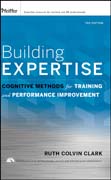
Building expertise: cognitive methods for training and performance improvement
Clark, Ruth Colvin
Building expertise is a key source of competitive advantage in the knowledge economy. Building Expertise meets this challenge by providing a guide for instructional designers, course developers, and technical communicators interestedin using research-based psychological theory to build effective training materials. Clark summarizes cognitive theories concerning working memory, long-term memory, and attention and describes instructional methods for each. This newedition contains an updated review of relevant research from cognitive and instructional design fields, revised practical guidelines for problem-centered instruction, motivation, transfer, and new action-oriented examples. INDICE: Introduction: Getting the Most from This Resource. PART I: FOUNDATIONS OF BUILDING EXPERTISE. Chapter 1: Expertise in the Global Economy. The Value of Expertise. What Is an Expert? Seven Lessons Learned About Experts. Chapter 2: Four Ingredients of Instruction. Which Media Are Best for Learning? Four Components of Learning. Three Views of Learning. Four Instructional Architectures. Chapter 3: No Yellow Brick Road. Instructional Components and Learning:No Yellow Brick Road. Graphics and Learning: A Journey Down the Yellow Brick Road. Factors That Influence Learning. Toward an Evidence-Based Profession. About the Numbers. Chapter 4: The Psychology of Building Expertise. Two Memoriesfor Learning. The Transformation of Content into Knowledge and Skills. Eight Principles for Instruction. PART II: BASIC LEARNING EVENTS PROVEN TO BUILD EXPERTISE. Optimizing Working Memory Resources. Chapter 5: How Working Memory Works. Working Memory: The Center of Learning. New Content Has a Short Self Life in Working Memory. Chess, Chunking, and Capacity Limits of Working Memory. What Happens When Working Memory Is Overloaded? Automaticity: A Working Memory Bypass. Visual and Auditory Components in Working Memory. Why Is Working Memory So Limited? Working Memory and Performance. Chapter 6: Managing Cognitive Load. Cognitive Load Management Principle. Methods That Bypass Working Memory. Methods That Minimize Content. Methods to Impose Content Gradually. Methods to Minimize Unproductive Mental Work. Methods to Maximize Working Memory Capacity. Chapter 7: Managing Attention. The High Price of Attention Failure. The Attention Principle. Instructional Methods to Support Attention. Optimizing Attentional Capacity in the Classroom. Methods to Focus Attention. Methods to Support Selective Attention. What Is Divided Attention? Methods to Minimize Divided Attention. Chapter 8: Leveraging Prior Knowledge. The Prior Knowledge Principle.Methods to Activate Prior Knowledge. Methods to Compensate for Limited Prior Knowledge. Avoid Activating Inappropriate Prior Knowledge. When to Use Prior Knowledge Methods. Chapter 9: Helping Learners Build Mental Models: Implicit Methods. The Building Mental Models Principle. Explicit and Implicit Encoding Methods. Implicit Methods to Build Mental Models. Graphics to Build Mental Models. Personalize Your Learning Environment. Include Deep-Level Learning Agent Dialogs. Provide Examples and Encourage Their Processing. Provide Effective Analogies. Include Process Content in Your Instruction. Offer Cognitive Support for Novice Learners. Chapter 10: Explicit Methods for Helping Learners Build Mental Models. Is Active Learning Better? A Tale of Four Lessons. Building MentalModels Principle. Explicit vs. Implicit Methods for Building Mental Models. Maintenance vs. Elaborative Rehearsal. Incorporate Frequent Elaborative Practice Exercises. The Law of Diminishing Returns. Distribute Practice Assignments. Provide Explanatory Feedback. Use Effective Questioning Techniques in the Classroom. Actively Engage Learners with Graphics. Promote Self-Explanations of Content. Incorporate Collaborative Learning Opportunities. Minimize Note-Taking in Instructor-Led Presentations. Who Benefits from Practice? Chapter 11: Learning Versus Performance: The Psychology of Transfer. Transfer: the Bridge from Training to Performance. Four Tales of Transfer Failure. Causes of Transfer Failure. The Transfer Challenge. Specific Versus General Theories of Transfer. The Transfer Continuum. Surface Versus Deep Structure and Transfer. Transfer and Intelligence. Chapter 12: Teaching for Transfer. Transfer: Its All About Context. Teaching for Near-Transfer Performance. Learning Aids for Near-Transfer Learning. Teaching for Moderate Transfer. Teaching for Far-Transfer Performance. Learning Aids for Guided-Discovery simulations. PART III: PROMOTING ADAPTIVE EXPERTISE AND MOTIVATION. Chapter 13: Problem-Centered Instruction. The Revival of Problem-Centered Learning. The Benefits of Problem-Centered Design. Three Problem-Centered Design Models. Model 1: Problem-Based Learning (PBL). Model 2: 4C/ID. Model 3: Sherlock and Cognitive Apprenticeship. Applying Problem-Centered Design. Issues in Problem-Centered Instruction. Reservations About Problem-Centered Instruction. Chapter 14: Metacognitive, Self-Regulation and Adaptive Expertise. Cognition, Metacognition, and Adaptive Expertise. Metacognition and Self-Regulation. Are Learners Self-Regulated? Supporting Self-RegulationDuring Learning. Domain-Specific Metacognitive Skills. Building Domain-Specific Metacognitive Skills. Chapter 15: Motivation and Expertise. Motivation for Learning. From Rewards to Beliefs: External vs. Internal Views of Motivation. Beliefs and Learning Choices. Beliefs About Learning Outcomes and Persistence.Goal Setting and Motivation. Chapter 16: Motivating Your Learners. Instructional Environments that Motivate. Evidence for Managing Learner Beliefs. PromoteSelf-Confidence by Structuring for Success. Encourage Mastery (Progress) GoalOrientations. Exploit Personal and Situational Interest. Techniques to Promote Cognitive Situational Interest. Leverage Personal Interest to Boost Motivation. Make Values Salient. PART IV: BUILDING EXPERTISE IN ACTION. Chapter 17: Practical Applications in Building Expertise. Adopting Evidence-Based Practice. What Is an Excellent Lesson? Sample 1: A Receptive Presentation on Cognitive Load. Sample 2: A Directive e-Lesson on Excel. Sample 3: A Guided-Discovery Classroom Workshop on e-Learning Design. Exploratory Architectures for Far-Transfer Learning. A Final Word. Glossary. References. Index. About the Author.
- ISBN: 978-0-7879-8844-9
- Editorial: Jossey Bass
- Encuadernacion: Cartoné
- Páginas: 512
- Fecha Publicación: 01/10/2008
- Nº Volúmenes: 1
- Idioma: Inglés
